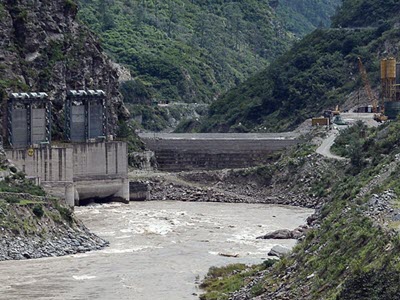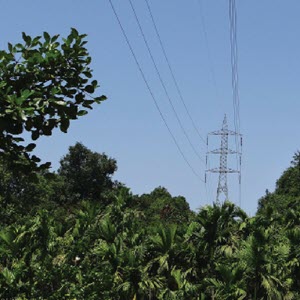Interview from Asia EDGE
Transnational Energy Projects as a Bridge to a More Peaceful and Prosperous South Asia
In the complicated geopolitical landscape of South Asia, identifying opportunities for cooperation can be challenging, especially when dealing with issues of importance for domestic security and development. Mirza Sadaqat Huda, a fellow at the OSCE Academy in Bishkek and an Asia EDGE Fellow at NBR, believes that transnational energy projects can help peacebuilding in the region by providing alternatives for collaboration in similarly important but potentially less contentious areas like energy trade and environmental sustainability.
NBR’s Thomas Lutken spoke with Dr. Huda about his research and conversations with stakeholders across the region. His new book Energy Cooperation in South Asia: Utilizing Natural Resources for Peace and Sustainable Development examines four transnational energy projects that demonstrate various planning mechanisms through which energy infrastructure can be designed to yield peacebuilding dividends.
Your book argues that cooperation on energy projects in South Asia can enhance peace and sustainable development. How do you make the link between energy and peacebuilding?
I make a distinction between two broad types of energy diplomacy that affect cooperation. First is the national security approach to energy diplomacy, which dominates the regional discourse on energy issues among policymakers in South Asia. Traditionally, energy diplomacy has been understood as the use of foreign policy to secure energy resources or markets in order to eliminate national threats and influence the direction of international events or trade.
Second is the peacebuilding approach to energy diplomacy, based on the idea that transnational energy projects can be conduits of diplomacy. Several policymakers in India and Pakistan believe that, despite political and security challenges, there is potential for cross-country pipelines to contribute to conflict resolution, particularly if projects are deliberately designed to encourage interdependence on collective outcomes. Interview respondents expressed similar opinions regarding regional hydroelectric projects between Bangladesh, Bhutan, India, and Nepal. However, the difficulty remains in translating these goals into concrete policy initiatives.
Your book examines both pipeline projects and hydroelectric initiatives. What can we learn from these that can be particularly useful for conflict resolution?
Ample scope exists for energy diplomacy in South Asia to facilitate more inclusive collaboration and deter conflicts. Current discourse on the Turkmenistan-Afghanistan-Pakistan-India (TAPI) pipeline, for example, only considers the national security interests of countries involved in the project. But pipelines in South Asia can be made more feasible if the interests of a broader groups of stakeholders, such as extraregional countries and local communities, are taken into account when planning these projects. Collaborative planning mechanisms for the development of pipelines could bring together the interests of countries, local communities, international organizations, and energy companies.
Relatedly, existing agreements on transnational rivers in South Asia have perpetuated the establishment of sovereign rights to water and focused on dividing rather than sharing natural resources. In addition, policymakers in countries that export hydroelectricity are concerned about the environmental impact of regional dams, while such issues receive little recognition in countries that might import this resource. For hydroelectric projects to be successful, they must be part of a broader initiative to collectively harness water and energy resources and manage environmental hazards in the Ganges-Brahmaputra-Meghna and Indus basins. In this way, environmental conservation as well as cross-border electricity trade can play a role in conflict resolution.
What is the most overlooked or underappreciated obstacle to energy cooperation that you found in your research?
Most studies highlight the primacy of political challenges but do not explain them beyond simplistic references to complex geopolitical issues, such as the India-Pakistan conflict over Kashmir. Political challenges to energy cooperation are essentially the failure of leadership in consensus building, positive engagement with extraregional actors, effective articulation of the benefits of regional cooperation, and bridging gaps between key stakeholders. For instance, a Nepali economist noted that one of the fundamental obstacles to energy cooperation is the way resources are conceptualized and communicated by politicians. To create broader consensus on energy cooperation, political leaders must shift the discourse on energy in South Asia from a focus on resource nationalism and the total value of resource deposits in a particular area to one that emphasizes the social, economic, and political benefits of collaborative resource utilization.
What role do civil-society or grassroots organizations have in facilitating South Asian energy cooperation?
While nonstate actors like NGOs and grassroots organizations can play an important role in advancing energy integration through advocacy and consensus building, the role of civil society in South Asian energy integration has been undermined by two regional trends within the last six years. First, the rise in autocratic and populist forms of governance has led to the shrinking of space for civil-society actors more broadly. In almost all countries of South Asia, governments have suppressed criticism and legitimate forms of dissent through arbitrary imprisonment and enforced disappearances.
Second, media and think tanks in the region that are responsible for providing unbiased and constructive perceptions of regional politics have broadly incorporated and amplified the nationalistic rhetoric of state actors. For example, in South Asia’s recent history, resource nationalism cultivated by politicians and domestic media has undermined hydroelectric cooperation between Nepal and India and gas trade between India and Bangladesh. The exclusionary policies of the Hindu nationalist government in India have been advanced by certain segments of civil society, further undermining regional cohesion.
Thus, any new, “out of the box” approaches to energy and broader regional integration are undermined by the conformity of civil-society actors to existing government policies.
How do international organizations or partner countries fit into this discussion?
International organizations have played an important role in facilitating energy cooperation. Multilateral development banks can advance regional cooperation in several ways. The most obvious role is that of providing financial assistance, as the World Bank has done with the Central Asia–South Asia (CASA-1000) power project or the Asian Infrastructure Investment Bank has done through investments in hydropower in Pakistan and solar farms in India. But these organizations can also provide crucial advisory and technical services. For example, the Asian Development Bank has played an instrumental role in bringing together the member countries of the TAPI pipeline on legal and commercial issues and in providing international legitimacy to this complex and controversial initiative. Additionally, USAID’s South Asia Regional Initiative for Energy Integration has undertaken advocacy and provided training and technical support toward cross-border energy trade for two decades.
One of the most important advantages of including international stakeholders and multilateral development banks within the regional cooperation agenda is that they can facilitate the implementation of international social and environmental standards, thereby enhancing the scope for sustainable development. For example, the International Finance Corporation’s Performance Standards require clients to meet certain benchmarks that are aimed at reducing the negative impacts of infrastructure development on vulnerable communities and the environment.
Has the Covid-19 pandemic raised the importance of regional cooperation in South Asia? What are the implications for the broader regional dynamics, including around transnational energy projects?
While the Covid-19 pandemic has heightened the overall awareness of interdependence, it has not galvanized concrete progress in regional cooperation through institutions like the South Asian Association for Regional Cooperation (SAARC). It also has not generated broader discussions on the need to expand the mandate and scope of regional organizations.
Since the cancellation of the summit in 2016, SAARC has become dormant. A video conference between SAARC leaders was held in March 2020, where Indian prime minister Narendra Modi tabled a regional approach to addressing the Covid-19 crisis. This lack of progress may be attributed to the inclusion of Article X in the institution’s charter, which enshrined the principle of unanimity in decision-making and excluded all bilateral and contentious issues from deliberations. These provisions have constrained the decision-making powers of SAARC and effectively eschewed the discussion of critical bilateral issues, thereby perpetuating conflicts and in turn eroding regional cooperation. As a result, unanimous decisions on issues like economic rebuilding that are influenced by unique domestic factors and national security concerns remain highly unlikely.
Energy cooperation in South Asia can play a critical role in regional integration and peacebuilding. However, this would require that planners of cross-border energy projects consider the interests of extraregional countries and nonstate actors, as well as environmental and socioeconomic impacts.
Mirza Sadaqat Huda is a Postdoctoral Research Fellow at the OSCE Academy in Bishkek and a 2020–21 Asia EDGE Fellow at NBR. He is the author of Energy Cooperation in South Asia: Utilizing Natural Resources for Peace and Sustainable Development (2020).
This interview was conducted by Thomas Lutken, a project associate with the Energy and Environmental Affairs group at NBR.



